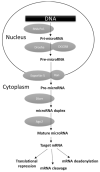Papillary Thyroid Cancer Prognosis: An Evolving Field
- PMID: 34771729
- PMCID: PMC8582937
- DOI: 10.3390/cancers13215567
Papillary Thyroid Cancer Prognosis: An Evolving Field
Abstract
Over the last few years, a great advance has been made in the comprehension of the molecular pathogenesis underlying thyroid cancer progression, particularly for the papillary thyroid cancer (PTC), which represents the most common thyroid malignancy. Putative cancer driver mutations have been identified in more than 98% of PTC, and a new PTC classification into molecular subtypes has been proposed in order to resolve clinical uncertainties still present in the clinical management of patients. Additionally, the prognostic stratification systems have been profoundly modified over the last decade, with a view to refine patients' staging and being able to choose a clinical approach tailored on single patient's needs. Here, we will briefly discuss the recent changes in the clinical management of thyroid nodules, and review the current staging systems of thyroid cancer patients by analyzing promising clinicopathological features (i.e., gender, thyroid auto-immunity, multifocality, PTC histological variants, and vascular invasion) as well as new molecular markers (i.e., BRAF/TERT promoter mutations, miRNAs, and components of the plasminogen activating system) potentially capable of ameliorating the prognosis of PTC patients.
Keywords: BRAF; TERT promoter; TNM; estrogen receptor; miRNA; molecular pathogenesis; plasminogen activating system; prognosis; therapy; thyroid cancers; tumor molecular profiling.
Conflict of interest statement
The authors declare no conflict of interest.
Figures


References
-
- Trimboli P., Ulisse S., Graziano F., Marzullo A., Ruggieri M., Calvanese A., Piccirilli F., Cavaliere R., Fumarola A., D’Armiento M. Trend in Thyroid Carcinoma Size, Age at Diagnosis, and Histology in a Retrospective Study of 500 Cases Diagnosed Over 20 Years. Thyroid. 2006;16:1151–1155. doi: 10.1089/thy.2006.16.1151. - DOI - PubMed
-
- Davies L., Morris L.G., Haymart M., Chen A.Y., Goldenberg D., Morris J., Ogilvie J.B., Terris D.J., Netterville J., Wong R.J., et al. American Association of Clinical Endocrinologists and American College of Endocrinology Disease State Clinical Review: The Increasing Incidence of Thyroid Cancer. Endocr. Pract. 2015;21:686–696. doi: 10.4158/EP14466.DSCR. - DOI - PMC - PubMed
Publication types
LinkOut - more resources
Full Text Sources
Research Materials

